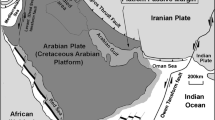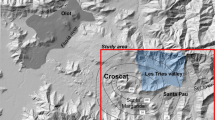Abstract
We investigate the sedimentological and mineralogical properties of a debris flow deposit west of Cayambe Volcanic Complex, an ice-clad edifice in Ecuador. The deposit exhibits a matrix facies containing up to 16 wt% of clays. However, the stratigraphic relationship of the deposit with respect to the Canguahua Formation, a widespread indurated volcaniclastic material in the Ecuadorian inter-Andean Valley, and the deposit alteration mineralogy differ depending on location. Thus, two different deposits are identified. The Río Granobles debris flow deposit (~1 km3) is characterised by the alteration mineral assemblage smectite + jarosite, and sulphur isotopic analyses point to a supergene hydrothermal alteration environment. This deposit probably derives from a debris avalanche initiated before 14–21 ka by collapse of a hydrothermally altered rock mass from the volcano summit. In contrast, the alteration mineralogy of the second debris flow deposit, which may itself comprise more than one unit, is dominated by halloysite + smectite and relates to a shallower and more recent (<13 ky) mass movement of high-altitude (>3200 m) volcanic soils. Our study reinforces the significance of hydrothermal alteration in weakening volcano flanks and in favouring rapid transformation of a volcanic debris avalanche into a clay-rich debris flow. It also demonstrates that mineralogical analysis provides crucial information for resolving the origin of a debris flow deposit in volcanic terrains. Finally, we posit that slope instability, promoted by ongoing subglacial hydrothermal alteration, remains a significant hazard at Cayambe Volcanic Complex.






Similar content being viewed by others
References
Bernard B (2008) Étude des dépôts d'avalanche de débris volcaniques: analyse sédimentologique d'exemples naturels et identification des mécanismes de mise en place . Université Blaise Pascal, FranceMsc Thesis
Bish DL, Post JE (1993) Quantitative mineralogical analysis using the Rietveld full-pattern fitting method. Am Mineral 78:932–940
Capra L, Macias JL (2000) Pleistocene cohesive debris flows at Nevado de Toluca Volcano, central Mexico. J Volcanol Geoth Res 102:149–167
Capra L, Macias JL, Scott KM, Abrams M, Garduno-Monroy VH (2002) Debris avalanches and debris flows transformed from collapses in the Trans-Mexican Volcanic belt, Mexico—behavior, and implications for hazard assessment. J Volcanol Geoth Res 113:81–110
Carrasco-Núñez G, Vallance GW, Rose WI (1993) A voluminous avalanche-induced lahar from Citlaltépetl volcano, Mexico: implications for hazard assessment. J Volcanol Geotherm Res 59:35–46
Clapperton CM, Vera R (1986) The Quaternary glacial sequence in Ecuador: a reinterpretation of the work of Walter Sauer. J Quaternary Sci 1:45–56
Colinvaux PA, Olson K, Liu KB (1988) Late-glacial and holocene pollen diagrams from two endorheic lakes of the inte-Andean plateau of Ecuador. Review Palaeobot Palyno 55:83–99
Crandell DR (1971) Postglacial lahars from Mount Rainier volcano, Washington. U.S. Geol Surv Prop Pap 677
Crandell DR (1989) Gigantic debris avalanche of Pleistocene age from ancestral Mount Shasta volcano, California, and debris-avalanche hazard zonation. U.S. Geol Surv Bull 1861
Fejdi P, Holocsy A (2001) Relationship between crystal morphology and preferred orientation in polycrystalline specimens for diffraction experiments. Mater Struct 8:22–24
Finn CA, Deszcz-Pan M, Anderson ED, John DA (2007) Three-dimensional geophysical mapping of rock alteration and water content at Mount Adams, Washington: implications for lahar hazards. J Geophys Res-Sol Ea 112:B10204
Folk RL, Ward WC (1957) Brazos river bar: a study of the significance of grain size parameters. J Sediment Petrol 27:3–26
Frolova JV, Ladygin VM, Rychagov S, Zukhubaya D (2014) Effects of hydrothermal alterations on physical and mechanical properties of rocks in the Kuril–Kamchatka island arc. Eng Geol 183:80–95
Glicken H (1996) Rockslide-debris avalanche of May 18, 1980, Mount St. Helens volcano, Washington. U.S. Geol Surv Open-file Report 96–677
Guillier B, Chatelain J-L (2006) Evidence for a seismic activity mainly constituted of hybrid events at Cayambe volcano, Ecuador: interpretation in a iced-domes volcano context. Compt Rendus Geosci 338:499–506
Hall ML, Mothes PA (1996) La edad y tasas de formacion de la Cangahua. In: Simposio “Suelos Volcanicos Endurecidos”, 7–14 December 1996, Quito
Henley RW, Ellis AJ (1983) Geothermal systems, ancient and modern. Earth Sci Rev 19:1–50
Houghton BF, Hegan BD (1980) A preliminary assessment of geological factors influencing slope stability and landslipping in and around Tauranga City. New Zealand Geological Survey Engineering Geology Report EG 348
Inman DL (1952) Measures for describing the size distribution of sediments. J Sediment Petrol 22:125–145
Inoue A (1995) Formation of clay minerals in hydrothermal environments. In: Velde B (ed) Origin and mineralogy of clays. Springer, Berlin, pp 268–329
Iverson RM, Reid ME, LaHusen RG (1997) Debris-flow mobilization from landslides. Annu Rev Earth Pl Sc 25:85–138
Iverson RM, Schilling SP, Vallance JW (1998) Objective delineation of lahar-inundation hazard zones. Geol Soc Am Bull 110:972–984
Joussein E, Petit S, Delvaux B (2007) Behavior of halloysite clay under formamide treatment. Appl Clay Sci 35:17–24
Pansu M, Gautheyrou J (2006) Handbook of soil analysis: mineralogical, organic and inorganic methods. Springer-Verlag, Berlin
Quantin P (1997) Régénération et Conservation des Sols Volcaniques Indurés et Stériles d'Amérique Latine (Chili, Equateur, Mexique). European Union Report:TS3–CT930252
Quantin P, Zebrowski C (1996) Analyse préliminaire (chimie, minéralogie, pétrographie) de quelques types de cangahua. Los suelos con cangahua en el Ecuador. In Memoria del III Simposio Internacional sobre Suelos Endurecidos, Quito, pp 29–47
Reid ME, Sisson TW, Brien DL (2001) Volcano collapse promoted by hydrothermal alteration and edifice shape, Mount Rainier, Washington. Geology 29:779–782
Robert M, Tessier D (1974) Méthode de préparation des argiles des sols pour des études minéralogiques. Ann Agron 25:859–882
Rodbell DT, Bagnato S, Nebolini JC, Seltzer GO, Abbot MB (2002) A late Glacial–Holocene tephrochronology for glacial lakes in southern Ecuador. Quat Res 57:343–354
Rye RO (2005) A review of the stable-isotope geochemistry of sulfate minerals in selected igneous environments and related hydrothermal systems. Chem Geol 215:5–36
Samaniego P, Monzier M, Robin C, Hall ML (1998) Late Holocene eruptive activity at Nevado Cayambe volcano, Ecuador. B Volcanol 59:451–459
Samaniego P, Eissen JP, Monzier M, Robin C, Alvarado A, Yepes H (2004) Los peligros volcanicos asociados con el Cayambe. Corporaciòn Editora Nacional, Quito
Samaniego P, Martin H, Monzier M, Robin C, Fornari M, Eissen JP, Cotten J (2005) Temporal evolution of magmatism in the Northern Volcanic Zone of the Andes: the geology and petrology of Cayambe Volcanic Complex (Ecuador). J Petrol 46:2225–2252
Sánchez MV, Genise JF, Bellosi ES, Román-Carrión JL, Cantil LF (2013) Dung beetle brood balls from Pleistocene highland palaeosols of Andean Ecuador: a reassessment of Sauer’s Coprinisphaera and their palaeoenvironments. Palaeogeogr Palaeocl 386:257–274
Scott KM, Vallance JW (1995) Debris flow, debris avalanche, and flood hazards at and downstream from Mount Rainier, Washington. U.S. Geol Surv Hydrol Inv Atlas HA-729:1–9
Scott WE, Pierson TC, Schilling SP, Costa JE, Gardner CA, Vallance JW, Major JJ (1997) Volcano hazards in the Mount Hood region, Oregon. U.S. Geol Surv Open-File Report 97–89
Scott KM, Macías JL, Naranjo JA, Rodríguez S, McGeehin JP (2001) Catastrophic debris flows transformed from landslides in volcanic terrains: mobility, hazard assessment, and mitigation strategies. U.S. Geoll Surv Prof Pap 1–59
Siebert L, Glicken H, Ui T (1987) Volcanic hazards from Bezymianny- and Bandai-type eruptions. B Volcanol 49:435–459
Stoopes GR, Sheridan MF (1992) Giant debris avalanches from the Colima Volcanic Complex, Mexico: implications for long-runout landslides (> 100 km) and hazard assessment. Geology 20:299–302
Taylor J (1991) Computer programs for standardless quantitative analysis of minerals using the full powder diffraction profile. Powder Diffract 6:2–9
Taylor J, Matulis C (1991) Absorption contrast effects in the quantitative XRD analysis of powders by full multiphase profile refinement. J Appl Crystallogr 24:14–17
Vallance JW (2005) Volcanic debris flows. In: Jakob M, Hungr O (eds) Debris-flow hazards and related phenomena. Springer, Berlin Heidelberg, pp 247–274
Vallance JW, Scott KM (1997) The Osceola mudflow from Mount Rainier: sedimentology and hazard implication of a huge clay-rich debris flow. Geol S Am 109:143–163
Wesley LD (1977) Shear strength properties of halloysite and allophane clays in Java, Indonesia. Géotechnique 27:125–136
Winckell A, Zebrowski C (1992) Cangahua in Ecuador: the paleogeographic context of its formation. Terrain 10:107–112
Wyatt J (2009) Sensitivity and clay mineralogy of weathered tephra-derived soil materials in the Tauranga region . University of Waikato, New ZealandMsc Thesis
Zehetner F, Miller WP, West LT (2003) Pedogenesis of volcanic ash soils in Andean Ecuador. Soil Sci Soc Am J 67:1797–1809
Zimbelman DR, Watters RJ, Firth IR, Breit GN, Carrasco-Núñez G (2004) Stratovolcano stability assessment methods and results from Citlaltépetl, Mexico. B Volcanol 66:66–79
Zimbelman DR, Rye RO, Breit GN (2005) Origin of secondary sulfate minerals on active andesitic stratovolcanoes. Chem Geol 215:37–60
Acknowledgements
MD is supported by a Belgium FNRS-aspirant studentship (2012-16, 1121315F). PD gratefully acknowledges Prof. Ernesto de la Torre and the Escuela Politécnica Nacional in Quito for facilitating field work. We warmly thank Jorge Bustillos and Evelyne Criollo for help in the field, Anne Iserentant for laboratory assistance and Philippe Sonnet and Alain Bernard for insightful discussion. Alain Bernard kindly provided access to SEM-EDX.
Author information
Authors and Affiliations
Corresponding author
Additional information
Editorial responsibility: L. Capra
Electronic supplementary material
ESM 1
(DOCX 3437 kb)
Rights and permissions
About this article
Cite this article
Detienne, M., Delmelle, P., Guevara, A. et al. Contrasting origin of two clay-rich debris flows at Cayambe Volcanic Complex, Ecuador. Bull Volcanol 79, 27 (2017). https://doi.org/10.1007/s00445-017-1111-2
Received:
Accepted:
Published:
DOI: https://doi.org/10.1007/s00445-017-1111-2




